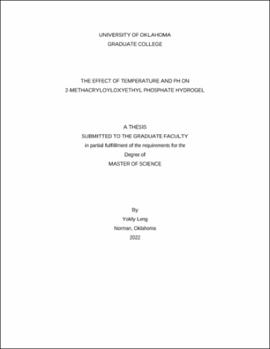| dc.description.abstract | Aqueous activators regenerated by electron transfer atomic transfer radical polymerization (aqueous ARGET-ATRP) is a well-understood polymerization technique that gives good control of the molecular weight of the final product. The regeneration of catalyst during polymerization reduces the amount of catalyst needed for the process. Reducing agents such as ascorbic acid are introduced and have shown great result with high oxygen tolerance. The polymerization conditions including pH, temperature, and solution composition could affect the final product of the polymerization. Aqueous ARGET-ATRP has shown great progress in polymerizing 2-methacryloyloxyethyl phosphate (MOEP). Current studies focused on the formation, gelation time and degree of swelling of poly(2-methacryloyloxyethyl phosphate) PMOEP.
In this study, the focus remained to be the degree of swelling of PMOEP, but in different solvents to better understand the interactions between PMOEP functional groups and solvents. It was found that salt solutions can be used to induce swelling of PMOEP with potassium chloride and sodium chloride showed similar rate of deswelling at 0.1M, but much lower than 0.1M calcium chloride and magnesium chloride solutions. Furthermore, the degree of swelling highly reduced when 0.1 M, 0.5M and 1M of sodium chloride, potassium chloride, calcium chloride and magnesium chloride solutions were used as solvent. The data shows that calcium chloride solution gives the lowest degree of swelling following by magnesium chloride, potassium chloride and sodium chloride, respectively. The increase in concentrations further decreased the rate and degree of swelling until a certain point at which concentrations do not affect the rate and degree of swelling anymore. It was also observed that after the first hour, the weight of hydrogels reduced significantly to lower than its initial weight when swelling in calcium chloride solutions. Scanning electron microscopy (SEM) and energy dispersive spectroscopy (EDS) were used to determine the structure and compositions of the dried hydrogel. PMOEP interacted with cations of salt solutions and cations were observed across the surface. Potassium chloride salt were observed on the surface of PMOEP swelled in all concentration of KCl solutions.
PMOEP has shown to have very little response to pH of the solvent. The change in pH at acidic conditions, very little change of degree of swelling was observed. However, the degree of swelling increased significantly around neutral pH of 7 and remain constant at higher basic pH. The increase in temperature resulted in a decrease in degree of swelling as well. However, temperature significantly affected the rate of swelling of PMOEP in calcium chloride solutions. The collapse of hydrogel was observed at 30 °C and 40 °C.
PMOEP was polymerized with 4T1 mouse breast cancer cells via aqueous ARGET-ATRP to show its ability to expand cells as part of the expansion microscopy study. The result did not show fruitful data due to its low-quality image. However, it was estimated that PMOEP could expand cells by two-fold, which could be very useful since the preparation of PMOEP is much easier and less time consuming compared to the method currently practiced.
The polymerization conditions were altered to better understand their impact on the properties of the PMOEP hydrogel. The study involved reactions performed at 30, 40, and 50 °C with 40%, 50% and 60% by v/v MOEP and at the native pH along with pH values of 1 and 1.5. Results for PMOEP made with 50% MOEP showed excellent shape retention across the temperature and pH ranges investigated. Except at 50 °C where the PMOEP gels showed multiple fractures and the gel color was light brown, which is different from the usual clear hydrogels observed at other synthesis temperatures. Compression testing showed that PMOEP polymerized at 40 °C with 50% MOEP and native pH had the highest measured strain and could show the original compressive strength even after multiple cycles if the force is below the stress to break the gel. Rat bone marrow stem cells (rBMSCs) were used for cytotoxicity study. rBMSCs were exposed and let to grow with the presence to PMOEP for 24 hours. rBMSCs showed great response to the gel with very few dead cells observed while continued to grow. This showed that PMOEP is not toxic tot cells. | en_US |

